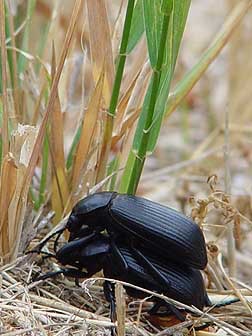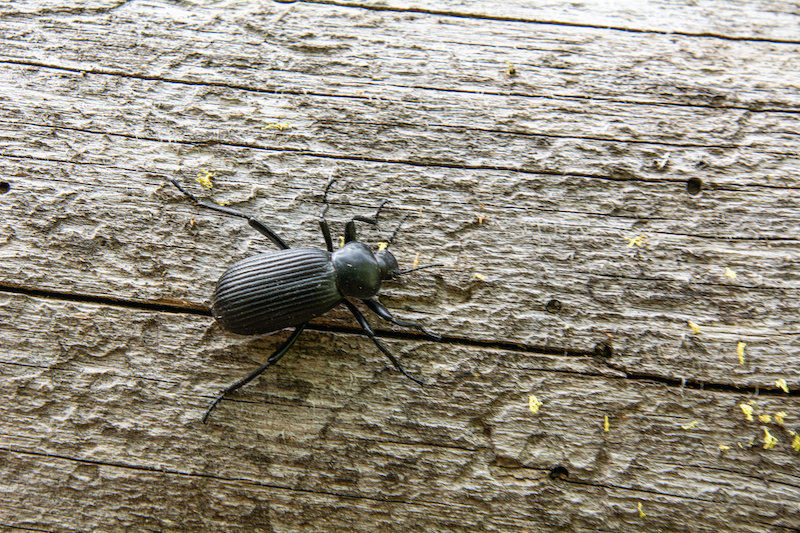When a blind beetle crawls over the surface of a globe he doesn’t notice that the track he has covered is curved. I was lucky enough to have spotted it. – Albert Einstein.
These are black beetles about 0.2 – 0.8 inches in size. The Family Tenebrionidae includes a number of genera and species that are commonly referred to as darkling beetles. Worldwide, there are an estimated 15,000 species in this family and over 1,300 in the U.S. Their color can range from black to brown or a dark rusty red. The carapace is smooth or may have bumps and ridges.
While they do have wings, species in arid regions, such as the one in the photo above, taken near Ellensburg, Washington, do not fly. That’s because their wings are fused shut, which prevents loss of moisture through evaporation. Mealworms sold in pet stores to feed your lizard, or whatever, are the larvae of a type of darkling beetle.
Darkling beetles can be found under stones, within hollow logs, or just roaming around the desert landscape. Some species forage on fungi while others feed on crops or decaying vegetation. Others are known to forage on carrion or dung.
Those in the Eleodes genus are common in arid areas of the west. Common names are pinacate beetle, skunk, stink, or head-stander beetle. Some species point their heads downward and point their backend upward to spray a noxious oil from the rear of their abdomen that burns the mouth, nose, and eyes of an animal attempting to eat it.
Some predators, such as grasshopper mice (which have learned to start with the head), burrowing owls, and pallid bats manage to prey upon darkling beetles. During winter some species seek shelter below ground in burrows of other animals and remain there until things warm up in the spring. Other species do not live overwinter as adults. These species lay eggs in the soil during the summer and die when it freezes. The larvae will live up to two years before the adults emerge to mate.

Following a mild winter there can be a population explosion of these beetles but they are generally kept in check by parasitoid wasps, such as braconid wasps, which lay their eggs on or within their host.
There are about 20 species of darkling beetles that can be found in eastern Washington. In the late ‘70s the Pacific Northwest Laboratory at the Hanford Site conducted an extensive darkling beetle study on the arid lands surrounding the closed nuclear site. Eighteen species of 10 genera were documented.
Among other things, they looked at what the beetles were eating compared to what was available. It is no small task looking at the vegetation fragments in a beetle’s stomach to identify what plants they prefer.
The Hanford study authors even developed an identification key for the species they found within their study area. From what I could figure out, I think (maybe) the species I came across is Eleodes humeralis but I would have to sit down with the key, the beetle, and a hand lens to be sure. So, for your next eastern Washington beetle hunt you might want to take along this document Darkling Beetle Key
A few weeks ago, I was hiking in the sagebrush of eastern Washington, just outside of Ellensburg, on Manashtash Ridge. From the ridge top we took a different route back to the car that looped through some open ponderosa pine stands with lots of downed and decaying logs.
The first photo shows the beetle I came across, but it wasn’t the only one we saw. I always called these stink beetles or stink bugs, but they are not bugs – those are insects of the order Hemiptera.
I took a few photos of the critter and then gave him a little poke with my finger and it instinctively raised its backside and pointed its head down. No reason to disturb it further so we continued the hike homeward.
